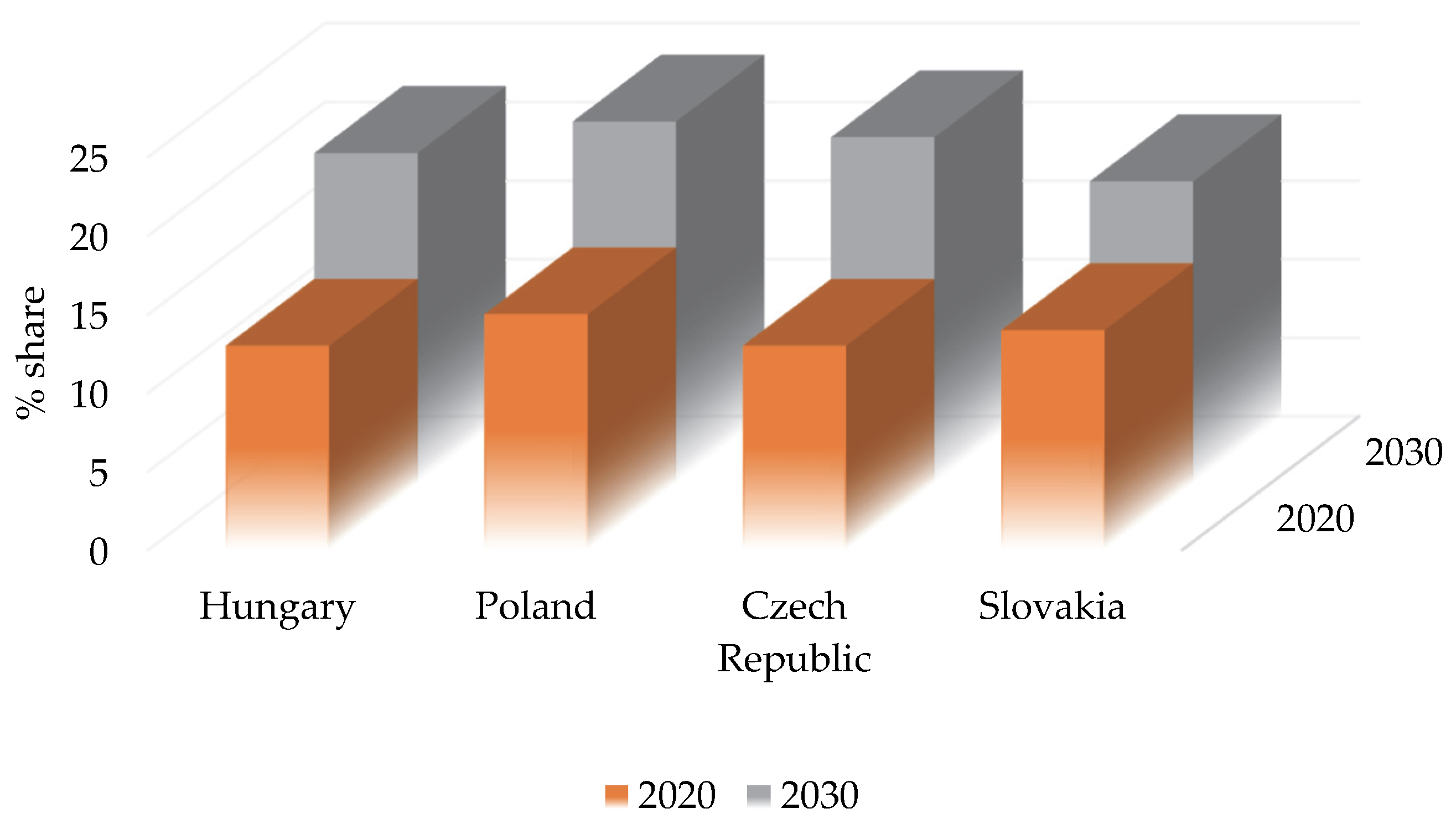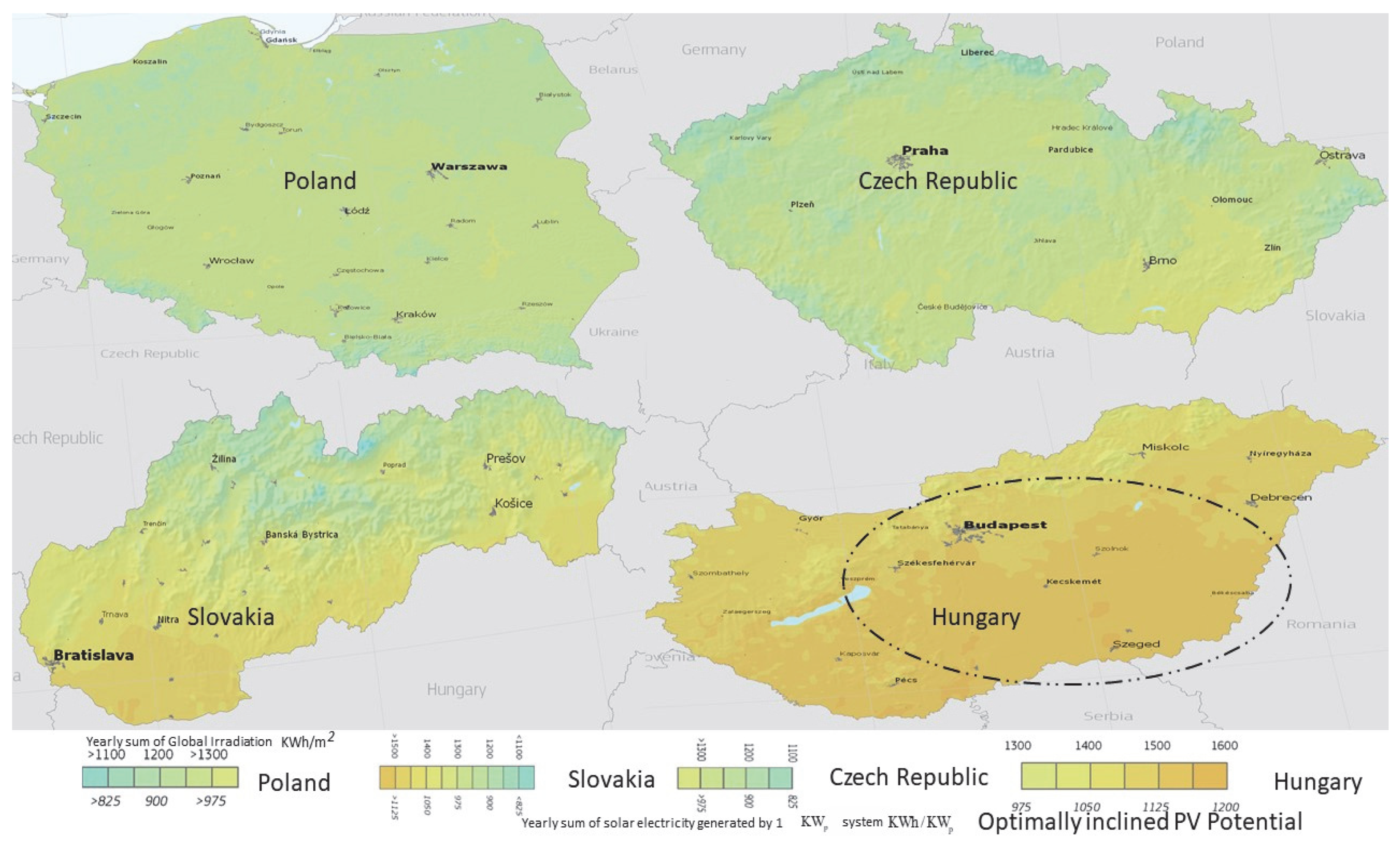Trendline Assessment of Solar Energy Potential in Hungary and Current Scenario of Renewable Energy in the Visegrád Countries for Future Sustainability
Abstract
1. Introduction
- The status of renewable energy consumption share trends in V4 Countries, focusing on Hungary as a case study for solar energy harnessing.
- Comparative study for the V4 countries on irradiation observation parameters through regional maps and graph trend analysis.
- Recent observation of the performance of grid-connected PV systems for a fixed angle. Profiling of various cities was conducted to observe their potential for the potential study of Hungary.
2. Overview of the Member State Positions
2.1. Poland
2.2. The Czech Republic
2.3. Slovakia
2.4. Hungary
2.5. Hungary as a Case Study for Solar Energy Potential
3. Materials and Methods
3.1. Indicators of the Analysis
3.2. Data and Analysis
4. Results and Discussions
4.1. Regression Analysis
4.2. Regional Map Analysis
4.3. Performance Assessment of a Grid-Connected PV System
- Budapest;
- Debrecen;
- Gyor;
- Kecskemét;
- Nyíregyháza;
- Pecs;
- Siófok;
- Kekesteto.
5. Conclusions
Author Contributions
Funding
Institutional Review Board Statement
Informed Consent Statement
Data Availability Statement
Conflicts of Interest
Abbreviations
| EU | European union |
| MWp | Megawatt peak |
| NECP | National Energy and climate plans |
| RES | Renewable Energy sources |
| GDP | Gross Development product |
| PV | Photovoltaic |
| TWh | Terawatt-hour |
| MW | Megawatt |
| GW | Gigawatt |
| EUR | Euro |
| RES | Renewable energy sources |
| SET | Solar energy technology |
| PV/T | Photovoltaic thermal |
| GIS | Geographic information system |
References
- Latawski, P. On Converging Paths? The Visegrad Group and the Atlantic Alliance. Paradigms 1993, 7, 78–93. [Google Scholar] [CrossRef]
- Khanam, T.; Rahman, A.; Mola-Yudego, B.; Pelkonen, P.; Perez, Y.; Pykäläinen, J. Achievable or unbelievable? Expert perceptions of the European Union targets for emissions, renewables, and efficiency. Energy Res. Soc. Sci. 2017, 34, 144–153. [Google Scholar] [CrossRef]
- European Commission. 2030 Climate & Energy Framework. Available online: https://ec.europa.eu/clima/policies/strategies/2030_en (accessed on 1 May 2021).
- Nosko, A.; Orban, A.; Paczynski, W.; Cernoch, F.; Jaros, J. Energy Security. Policy Paper, Visegrad Security Cooperation Initiative. 2010. Available online: https://www.visegradgroup.eu/download.php?docID=139html (accessed on 13 May 2021).
- European Commission. NECP HUNGARY. 2018. Available online: https://ec.europa.eu/energy/sites/ener/files/documents/ec_courtesy_translation_hu_necp.pdf (accessed on 2 May 2021).
- European Commission. NECP of European Countries. Available online: https://ec.europa.eu/energy/topics/energy-strategy/national-energy-climate-plans_en (accessed on 1 May 2021).
- Eurostat DATA. 2020. Available online: https://ec.europa.eu/eurostat/cache/infographs/energy/bloc-4c.html (accessed on 1 May 2021).
- Dyduch, J.; Skorek, A. Go South! Southern dimension of the V4 states’ energy policy strategies—An assessment of viability and prospects. Energy Policy 2020, 140, 111372. [Google Scholar] [CrossRef]
- Renewables Networking Platform. Renewables in National Energy and Climate Plans of Visegrad Countries Challenging the Low Ambition. Available online: https://www.komoraoze.cz/download/pdf/169.pdf (accessed on 2 May 2021).
- Papiez, M. CO 2 emissions, energy consumption and economic growth in the Visegrad Group countries: A panel data analysis. Math. Methods Econ. 2013, 2013, 696–701. [Google Scholar]
- Wawrzyniak, D. CO2 emissions in the Visegrad Group countries and the European Union climate policy. Comp. Econ. Res. 2020, 23, 73–92. [Google Scholar] [CrossRef]
- Zapletalová, V.; Komínková, M. Who is fighting against the EU’s energy and climate policy in the European Parliament? The contribution of the Visegrad Group. Energy Policy 2020, 139, 111326. [Google Scholar] [CrossRef]
- Gulkowski, S.; Zdyb, A. Performance Assessment of Four Different Photovoltaic Technologies in Poland. Energies 2020, 13, 196. [Google Scholar]
- IEO. PV MARKET IN POLAND. 2020. Available online: https://ieo.pl/en/pv-report (accessed on 3 May 2021).
- Ministry of Energy. Extract from the Draft of Energy of Poland until 2040 (EPP2040). Available online: https://www.gov.pl/attachment/376a6254-2b6d-4406-a3a5-a0435d18be0f#:~:text=The%20Energy%20Policy%20of%20Poland,delivered%20in%20the%20medium%2Dterm (accessed on 3 May 2021).
- Valentova, M.; Knápek, J.; Mikeska, M.; Vašíček, J. Investment Needs for 2030 Energy and Climate Targets in Czechia, Buildings and Renewable Energy Supply Sectors Executive Summary. 2020. Available online: https://www.ikem.de/wp-content/uploads/2020/03/Valentova-et-al.-2020.-Investment-need-analysis-in-Czechia_Executive-Summary_in-English.pdf (accessed on 2 May 2021).
- Macháč, J.; Zaňková, L. Renewables—To build or not? Czech approach to impact assessment of renewable energy sources with an emphasis on municipality perspective. Land 2020, 9, 497. [Google Scholar] [CrossRef]
- Ministry of Trade and Industry of the Czech Republic. National Energy and Climate Plan of the Czech Republic. Eur. Comm. 2019, 437. Available online: https://ec.europa.eu/energy/sites/ener/files/documents/cs_final_necp_main_en.pdf (accessed on 1 May 2021).
- Hofierka, J.; Cebecauer, T. Spatially distributed assessment of solar resources for energy applications in Slovakia. Acta Fac. Stud. Humanit. Naturae Univ. Presoviensis Prírodné Vedy Folia Geogr. 2008, 12, 97–114. [Google Scholar]
- European Comission. National Energy and Climate Plan of Hungary. 2018. Available online: https://ec.europa.eu/energy/sites/default/files/documents/ec_courtesy_translation_hu_necp.pdf (accessed on 1 May 2021).
- Barwicki, J.; Kuboń, M.; Marczuk, A. New Developments of Solar Energy Utilization in the Aspect of EU Directives. Agric. Eng. 2017, 21, 15–24. [Google Scholar] [CrossRef][Green Version]
- Talamon, A. Global renewable energy trends and Hungary. Int. Rev. Appl. Sci. Eng. 2012, 3, 81–85. [Google Scholar] [CrossRef]
- Pintér, G.; Zsiborács, H.; Baranyai, N.H.; Vincze, A.; Birkner, Z. The economic and geographical aspects of the status of small-scale photovoltaic systems in hungary—A case study. Energies 2020, 13, 3489. [Google Scholar] [CrossRef]
- Vokas, G.A.; Zoridis, G.C.; Lagogiannis, K.V. Single and Dual Axis PV Energy Production over Greece: Comparison between Measured and Predicted Data. Energy Procedia 1490, 2015, 74–1498. [Google Scholar] [CrossRef]
- Park, S.; Kim, Y.; Ferrier, N.J.; Collis, S.M.; Sankaran, R.; Beckman, P.H. Prediction of Solar Irradiance and Photovoltaic Solar Energy Product Based on Cloud Coverage Estimation Using Machine Learning Methods. Atmosphere 2021, 12, 395. [Google Scholar] [CrossRef]
- European Commission. PHOTOVOLTAIC GEOGRAPHICAL INFORMATION SYSTEM. Available online: https://re.jrc.ec.europa.eu/pvg_tools/en/ (accessed on 2 May 2021).
- Kumar, R.; Rosen, M.A. A critical review of photovoltaic-thermal solar collectors for air heating. Appl. Energy 2011, 88, 3603–3614. [Google Scholar] [CrossRef]
- Šúri, M.; Huld, T.A.; Dunlop, E.D.; Ossenbrink, H.A. Potential of solar electricity generation in the European Union member states and candidate countries. Sol. Energy 1295, 2007, 81–1305. [Google Scholar] [CrossRef]
- Ŝúri, M.; Hofierka, J. A new GIS-based solar radiation model and its application to photovoltaic assessments. Trans. GIS 2004, 8, 175–190. [Google Scholar] [CrossRef]
- Tsoutsos, T.; Frantzeskaki, N.; Gekas, V. Environmental impacts from the solar energy technologies. Energy Policy 2005, 33, 289–296. [Google Scholar] [CrossRef]
- Alamdari, P.; Nematollahi, O.; Alemrajabi, A.A. Solar energy potentials in Iran: A review. Renew. Sustain. Energy Rev. 2013, 21, 778–788. [Google Scholar] [CrossRef]
- Eurostat DATA. Eurostat. 2019. Available online: https://ec.europa.eu/eurostat/databrowser/view/NRG_IND_REN__custom_29122/bookmark/line?lang=en&bookmarkId=15508b69-e68c-4d60-a6cf-f2e0d96d67d7 (accessed on 2 May 2021).
- Brown, A.M. A step-by-step guide to non-linear regression analysis of experimental data using a Microsoft Excel spreadsheet. Comput. Methods Programs Biomed. 2001, 65, 191–200. [Google Scholar] [CrossRef]
- Magyar Epitok. Available online: https://magyarepitok.hu/rohamtempoban-bovul-hazai-napenergia-felhasznalas (accessed on 2 May 2021).
- SOLAR BAY. Understanding How Solar Power Is Measured: MWp, MWac and MWh. Available online: https://solarbay.com.au/portfolio-item/understanding-how-solar-power-is-measured/ (accessed on 1 May 2021).
- Kam, O.M.; Noël, S.; Ramenah, H.; Kasser, P.; Tanougast, C. Comparative Weibull distribution methods for reliable global solar irradiance assessment in France areas. Renew. Energy 2021, 165, 194–210. [Google Scholar] [CrossRef]
- Yu, C.; Khoo, Y.S.; Chai, J.; Han, S.; Yao, J. Optimal orientation and tilt angle for maximizing in-plane solar irradiation for PV applications in Japan. Sustainability 2019, 11, 2016. [Google Scholar] [CrossRef]
- European Commission. Country and Regional Maps. Available online: https://re.jrc.ec.europa.eu/pvg_download/map_index.html (accessed on 2 May 2021).
- Solargis. Solar Resource Maps and GIS Data for 200+ Countries. Available online: https://solargis.com/maps-and-gis-data/download (accessed on 2 May 2021).
- Power, H.C.; Mills, D.M. Solar radiation climate change over southern Africa and an assessment of the radiative impact of volcanic eruptions. Int. J. Climatol. 2005, 25, 295–318. [Google Scholar] [CrossRef]













| 2010 | 2011 | 2012 | 2013 | 2014 | 2015 | 2016 | 2017 | 2018 | |
|---|---|---|---|---|---|---|---|---|---|
| Biomass | 67.4 | 56.4 | 50.4 | 51.3 | 54.0 | 51.4 | 45.8 | 47.3 | 48.1 |
| Biogas | 3.9 | 7.9 | 8.0 | 9.6 | 9.1 | 9.1 | 10.2 | 10.0 | 8.8 |
| Wind | 17.7 | 23.1 | 29.1 | 25.7 | 20.8 | 21.5 | 21.0 | 21.8 | 16.2 |
| Hydro | 6.2 | 8.2 | 8.0 | 7.6 | 9.6 | 7.2 | 8.0 | 6.3 | 5.9 |
| Solar | 0.0 | 0.0 | 0.3 | 0.9 | 2.1 | 4.4 | 7.5 | 10.1 | 16.6 |
| Rank | Solar Park | Capacity (MW) | Location | Established in Year |
|---|---|---|---|---|
| 1 | Kaba Solar Park (UC) | 43 | Kaba | 2020 |
| 2 | Kapuvár Solar Park | 25 | Kapuvár | 2020 |
| 3 | Paks Solar Park | 20.6 | Paks | 2019 |
| 4 | Mátra Solar Power Plant | 20 | Bükkábrány | 2019 |
| 5 | Felsőzsolca Solar Park | 20 | Felsőzsolca | 2018 |
| 6 | Duna Solar Park | 17.6 | Százhalombatta | 2018 |
| 7 | Szügy Solar Park | 16.5 | Szügy | 2019 |
| 8 | Mátra Solar Power Plant | 16 | Visonta | 2015 |
| 9 | Tiszaszőlős Solar Park | 11.6 | Tiszaszőlős | 2019 |
| 10 | Pécs Solar Park | 10 | Pécs | 2016 |
| Rank | Location | Capacity M.W. | Established in Year |
|---|---|---|---|
| 1 | Csepreg | 5.5 | 2018 |
| 2 | Vep | 4.5 | 2018 |
| 3 | Monor | 4 | 2018 |
| 4 | Sajóbábony | 0.5 | 2016 |
| 5 | Szombathely | 0.385 | 2015 |
| 6 | Bojt | 0.49 | 2014 |
Publisher’s Note: MDPI stays neutral with regard to jurisdictional claims in published maps and institutional affiliations. |
© 2021 by the authors. Licensee MDPI, Basel, Switzerland. This article is an open access article distributed under the terms and conditions of the Creative Commons Attribution (CC BY) license (https://creativecommons.org/licenses/by/4.0/).
Share and Cite
Kumar, B.; Szepesi, G.; Čonka, Z.; Kolcun, M.; Péter, Z.; Berényi, L.; Szamosi, Z. Trendline Assessment of Solar Energy Potential in Hungary and Current Scenario of Renewable Energy in the Visegrád Countries for Future Sustainability. Sustainability 2021, 13, 5462. https://doi.org/10.3390/su13105462
Kumar B, Szepesi G, Čonka Z, Kolcun M, Péter Z, Berényi L, Szamosi Z. Trendline Assessment of Solar Energy Potential in Hungary and Current Scenario of Renewable Energy in the Visegrád Countries for Future Sustainability. Sustainability. 2021; 13(10):5462. https://doi.org/10.3390/su13105462
Chicago/Turabian StyleKumar, Baibhaw, Gábor Szepesi, Zsolt Čonka, Michal Kolcun, Zsolt Péter, László Berényi, and Zoltán Szamosi. 2021. "Trendline Assessment of Solar Energy Potential in Hungary and Current Scenario of Renewable Energy in the Visegrád Countries for Future Sustainability" Sustainability 13, no. 10: 5462. https://doi.org/10.3390/su13105462
APA StyleKumar, B., Szepesi, G., Čonka, Z., Kolcun, M., Péter, Z., Berényi, L., & Szamosi, Z. (2021). Trendline Assessment of Solar Energy Potential in Hungary and Current Scenario of Renewable Energy in the Visegrád Countries for Future Sustainability. Sustainability, 13(10), 5462. https://doi.org/10.3390/su13105462









